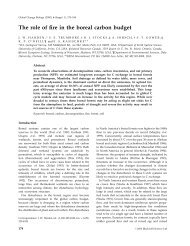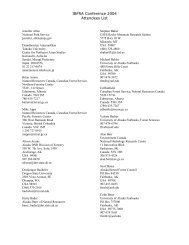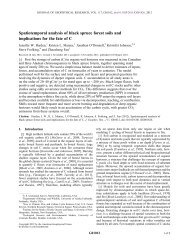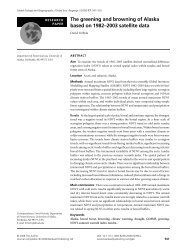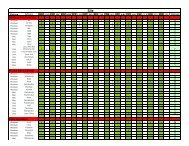Chapin, F.S., III, M.D. Robards, H.P. Huntington, J.F. Johnstone, S.F. ...
Chapin, F.S., III, M.D. Robards, H.P. Huntington, J.F. Johnstone, S.F. ...
Chapin, F.S., III, M.D. Robards, H.P. Huntington, J.F. Johnstone, S.F. ...
Create successful ePaper yourself
Turn your PDF publications into a flip-book with our unique Google optimized e-Paper software.
F. S. <strong>Chapin</strong> et al., Directional Changes in Ecological Communities<br />
02/26/2007 07:26 AM<br />
single manipulated factor. For example, nitrogen supply or some more slowly changing variable such as<br />
abundance of nitrogen fixers would be considered a critical variable in a forest whose structure responded<br />
strongly to nitrogen addition or to the invasion of exotic nitrogen-fixing species (Vitousek et al. 1987).<br />
Similarly, reindeer would be considered a critical variable in a culture that was disrupted by loss of reindeerherding<br />
opportunities. In this article, we are particularly interested in critical slow variables and parameters,<br />
factors that change so slowly (or events that occur so infrequently; e.g., wildfire) that they are frequently<br />
overlooked by managers but that have profound effects on community structure. In most ecosystems, there<br />
are a few (perhaps three to five) critical slow variables that strongly influence community structure and<br />
ecosystem functioning (Carpenter et al. 2002). Many critical slow variables are changing directionally—that<br />
is, there is a trend in their mean value over time—as a result of increasing human modification of the global<br />
environment.<br />
We must integrate social and ecological processes in a common conceptual framework if we want to<br />
predict changes in ecological communities in an increasingly human-dominated world. We approach this<br />
problem by first presenting hypotheses that predict community responses to those critical slow ecological<br />
variables that are most strongly affected by human activities. We then consider the circumstances under<br />
which society is most likely to address and modify these ecological impacts. None of our individual<br />
hypotheses are new. However, collectively they define a new framework for predicting the response of<br />
ecological communities or social-ecological systems to recent environmental, biotic, and social changes.<br />
Conceptual Framework<br />
Hypotheses based on steady state assumptions (table 1) provide a fundamental starting point for<br />
predicting the structure and dynamics of ecological communities, especially where direct human impacts<br />
have been modest (Pickett et al. 1992). Each of the hypotheses in table 1 predicts patterns of community<br />
structure or dynamics over commonly observed ranges of predictor variables when other potential influences<br />
(e.g., human impacts) are held relatively constant. Spatial variation in ecosystem structure, for example, has<br />
been predicted from a suite of independent control variables (state factors) that are treated as constant<br />
parameters over ecologically important timescales. These state factors include climate, the regional species<br />
pool, topography, and geological substrate (Jenny 1980; <strong>Chapin</strong> et al. 2002). Recently, however, human<br />
activities have substantially altered climate (Prentice et al. 2001), species pool (Sala et al. 2000), and<br />
geological impacts on ecosystems (Driscoll et al. 2001) over decadal timescales, so a steady state relationship<br />
between state factors and ecosystem structure may no longer apply. Human activities have also altered many<br />
of the other predictor and response variables listed in table 1, so the steady state assumptions underlying<br />
many community prediction hypotheses are no longer sufficient to predict future community structure and<br />
dynamics. Consequently, maps of potential vegetation based on simple prediction rules diverge increasingly<br />
from vegetation patterns detected by satellites.<br />
We view ecological and human communities as subsystems of a social-ecological system (Berkes and<br />
Folke 1998). The subsystems are linked by human impacts on ecosystems and ecosystem services that benefit<br />
file:///private/var/tmp/folders.501/TemporaryItems/com.apple.mail/compose/attach/<strong>Chapin</strong>2006AmNat.webarchive<br />
Page 3 of 21



